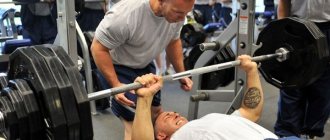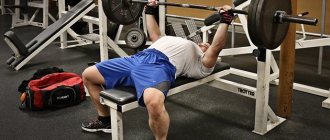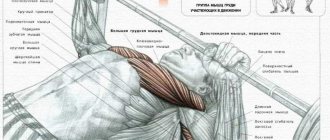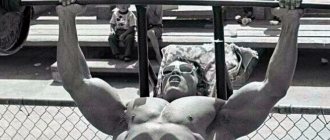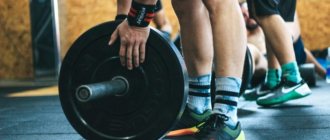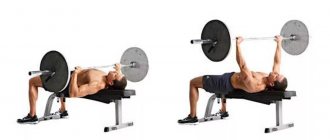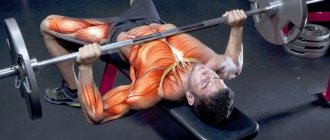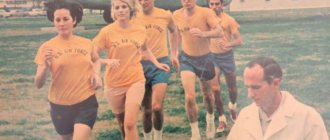The reverse dumbbell press is great for working all the heads of the triceps. The basic exercise develops not only physically, but also aesthetically, forming a beautiful relief. You can do it both in the gym and at home.
If you don’t know where to stop for high-quality work on the triceps muscle, include the reverse grip dumbbell press in the program. An excellent result will not take long to arrive.
Execution technique
Initial position
- The athlete places dumbbells on his hips;
- Lies down on the bench;
- Brings the weight up with the hips to the position of the top point of the press;
- Or assistants bring dumbbells up to him.
Movement
- Bend your elbows and lower the weight to your chest;
- Work in such a way that your forearms move along the body;
- Lower the dumbbells to your chest;
- Press the dumbbells up using your triceps;
- During the press, the palm is directed towards the head.
Dumbbell Reverse Press
Attention
- The exercise is not aimed at training the bridge, but at developing the triceps. You can do a slight arch in your back to protect your shoulders, but you should not deliberately perform the exercise only at the expense of the bridge;
- The movement should not be performed in jerks, it is done smoothly and uniformly;
- You should not bring the weight up due to the impulse from your legs, even if you choose to rest your feet on the floor and shoulder blades on the bench, you do not need to additionally push your legs from the floor.
- Try to do without excessive weights in this exercise; it was not invented for setting strength records. It is for slow and isolated triceps work.
Muscles involved
Professionals prefer to begin training this exercise after the rear deltoids have been warmed up with light weight swing exercises.
If the exercise is performed correctly, the load is distributed as follows: deltoids, triceps, chest, back.
- The main load is placed on the middle and anterior bundles of the deltoid muscles.
- The secondary load falls on the upper back and upper chest muscles.
- Indirect load affects the triceps and posterior deltoid muscles.
- The work includes the trapezius muscles, gluteal muscles, as well as the abs and thighs.
Regularly performing the military press allows you to get expressive shoulders and significantly expand your deltoids.
For athletes involved in weightlifting, this exercise makes it possible to increase explosive strength and improve the mobility of the joints of the shoulder girdle.
Changing body position and grip width provides load on various parts of the shoulder girdle. If you strictly follow the execution technique, you can achieve impressive results in a fairly short period of time.
Execution options
- Press with elbows raised to the sides . This press focuses more on the triceps than the anterior deltoid. It is not indicated for those who, due to the structural features of the shoulder, are unable to lower the dumbbells to their full amplitude in this position;
- Reverse grip bench press with barbell . There are benchers who find it more convenient to work in a competitive exercise this way. But the reverse grip bench press with a barbell is not recognized by most powerlifting federations. That does not prevent it from being a good auxiliary exercise and helping in muscle development.
How to do a military press correctly
Increasing your military bench weights will provide benefits in the form of additional core work, balance training, and bench press progress. This exercise will also set you apart from other athletes in the gym.
Create a training program
Thoughtful selection of exercises is of great importance. If you really want to improve your performance and build muscle mass, you can’t train “to suit your mood” and expect results. Iron doesn't like slackers. If I had tailored my strength training to my whims, I wouldn’t look nearly as good as I do now. So make a training plan and note your progress.
Film yourself
In addition to recording the results of classes, it is worth recording at least some of your working approaches on video. This makes it easier to track changes in shape and visible development. This is also a very useful tool that clearly demonstrates all the weaknesses and errors in technology.
Progressive weights
It is impossible to develop muscle strength without increasing the weights or the number of repetitions in the approach. To strengthen your body, try to add an extra 5 pounds to your barbell each week.
Do all reps the same way
When you push yourself as hard during your warm-up sets as you would during your most intense work reps, your body adapts to the load by learning proper and safe exercise technique. Likewise, if you do not perform the exercise correctly when warming up, you risk the quality of your work approaches and your own health.
Trust your body
When lifting scary heavy weights, you have to believe in yourself. You've put a lot of blood and sweat into achieving perfection in a particular exercise. Therefore, if you banish unnecessary thoughts and just press, you will be surprised at what you are capable of.
Training frequency
I have come to the conclusion that two bench sessions per week is sufficient. Try exercising twice a week with at least two rest days in between, and see how your body reacts. You can work with heavy weights once a week. But some people find it very difficult to progress in bench presses, so a two-day program will be more effective for them.
Take some serious weights
Make friends with the heavy military press. I have found that heavy weights and low rep ranges produce better results. It’s more common for me to do 5 repetitions in one approach. Sometimes I bench lighter weights more times. Experiment with different set and rep schemes and choose the one that works best for you.
Pull your head back and don't stick out your chin
If you use proper military press technique, your face will move forward, crossing the path of the bar. I teach my students to move their heads back without sticking their chin up. I broke my chin more than once before I got used to this technique.
Just imagine a chicken retracting its neck and head, moving them backward. If you like to tuck your chin in, try this method. I guarantee you will appreciate it.
Grip width
The grip width in the military press is more complicated than in other exercises. It can only be determined by trial and error. Start by extending your arms in front of you and grasp the bar in that position. My grip width here is almost the same as a close grip bench press. It's terrible, but I feel more comfortable this way.
If you feel like your grip is too wide, it probably is. The wider the grip, the more the shoulders are loaded. After all, this is a basic exercise, why upset the mechanical balance?
Try a false grip
If you don't know what a false grip looks like, grab the bar in the usual way and place your thumb on the other side in line with the rest of your fingers. It's best to see once, so I'll show you exactly what I mean.
I use my rubberized bodybar for stretches. This method allows you to keep the bar a little closer to your center of gravity.
Two reasons to use the false grip with caution:
- The bar can easily slip out of your hands and fall. This is why it is often prohibited to bench press with this grip.
- You may sprain your wrist. If you are not careful, you will feel increased tension in the wrist area.
A false grip allows you to increase your bench press strength. If you or your friends see that this is not the case, then the reason should be looked for in something else.
Grip the bar tighter
Gripping the bar tighter will cause a reaction throughout your body, stimulating the rest of your muscles to contract. This will eliminate excessive core mobility during the exercise. An awkward, relaxed posture can result in injury or the barbell falling on the athlete's head.
Tense your whole body
The more you tense your body muscles, the more powerful the press will be. A stable and rigid position allows you to apply more force.
“Point your chest up, squeeze your buttocks, tighten your quadriceps and abs.”
To achieve maximum bench strength and perfect form, remember these simple guidelines. Keeping your chest forward will help keep your body in a position where the bar is near your center of gravity, providing the best leverage for applying force.
Tight glutes and tight quads will keep you from swinging, making it easier for yourself. Your body will be motionless and solid, which will ensure impeccable pressing technique. Strong abs = stable core = good.
Strong upper back muscles
“A strong back will help with any bench press.” – Jonathan Byrd
In short, do a variety of lifts.
Powerful legs
Developed leg muscles play the role of a reliable foundation on which you will push the barbell. A strong body is built from the bottom up. Don't skip leg day.
Mighty lats
Lat power primarily affects the bench press, so be sure to do pull-ups and don't neglect rows. The more trained your back is, the more you will squeeze. Take an empty bar and feel how your lats contract as you lower it. Find the most optimal amplitude and work in it.
The bar is closer to the center of gravity
By placing the bar almost above the level of your feet, you can achieve a better press. Watch athletes with the correct military press technique - they skillfully balance, immediately “substituting” their head directly under the bar.
The snatch and push presses are two Olympic lifts in which the center of gravity plays a key role.
Don't lean back
If you've watched YouTube videos of athletes performing military presses, you've probably seen weirdos bending backwards so much that it looks like their back is about to snap in half. Pushing your torso back changes the dynamics of the exercise, making it more like an incline press than a basic shoulder exercise.
By distorting your technique, you will, of course, be able to squeeze out more, but this will in no way contribute to progress in the military bench press. Don't swing your body unless you're going to cheat or end up hurt.
Be careful when performing the push press
The push press is a great exercise. But when doing the military press, try not to help yourself with your legs. The push press is nothing more than a variation of the military press that actively involves the legs.
The only time you are allowed to push with your legs is during the last incredibly hard rep of a military press workout. You can also use this trick to seriously overload your muscles. Remember to engage your entire body and pay attention to your form if you really want to succeed in the military press.
Don't slouch
Presses cause the pectoral muscles to become tight. This causes the shoulders to turn inward and move forward, which causes poor posture. In addition, shoulder pain syndrome and other troubles may develop, turning training into hellish torment and resulting in injury in the long run.
Stretch your pectoral muscles and shoulders as much as possible. This way you will take care of the health of your shoulder muscles and allow them to maintain the correct position during the press. This determines the benefits of traction exercises for various bench presses. The body functions better in conditions of muscular balance.
Role of the rotator cuff
I was always lazy and didn't pay enough attention to working the rotator cuff muscles. I paid for my ignorance with an injury that took over a year to recover from before I was able to get back into shape and bench heavy weights again. Shoulder health, mobility, and good rotator cuff balance should be your first priority if you plan to stay in shape for years to come.
Which type of military press to choose for your goals?
There are several variations of this exercise: standing and sitting, with a barbell or dumbbells. Each of them is good in its own way, and the choice depends on your goals.
To press more weight
As a rule, the working weight in an exercise with dumbbells is 7% less Effects of Body Position and Loading Modality on Muscle Activity and Strength in Shoulder Presses than with a barbell. Firstly, removing the barbell from the racks is easier than lifting the dumbbells to shoulder level. Secondly, by squeezing the bar, you do not waste energy on stabilizing the weight in your hands.
For maximum results, try bench presses while seated. This way your body uses fewer muscles, which means you can do more. The difference in weights will be about 10%.
To load more muscle groups
Although you can press heavier weights while sitting, working while standing puts more stress on the entire shoulder girdle. The greatest activation of the deltoid muscles occurs during exercises with dumbbells, triceps and biceps - with a barbell.
Moreover, the standing press recruits more muscles overall, which increases the energy required for the exercise and teaches the body to move in a coordinated and efficient manner.
To relieve stress on your back
Seated barbell and dumbbell presses reduce the load on the lower back. Therefore, if you have problems with your spine, perform this movement with your back pressed against the bench.
To remove imbalance
It often happens that one hand is slightly behind the other in strength. By working with a barbell, you will be able to transfer the load to a stronger limb, which often happens. But if you take dumbbells, both hands will work equally, which will avoid imbalance.
To pump up your shoulders faster
The military press with dumbbells loads the shoulders better than the same weight with a barbell. This occurs due to instability: the body has to turn on more muscle fibers. But at the same time, it cannot be said that dumbbells are definitely better at pumping up your shoulders, since you can take less weight than when working with a barbell.
For optimal load on the shoulders and constant progress, it is recommended to alternate free weights at long intervals. For example, you can perform the military press with a barbell for 8-12 weeks, and then replace it with a dumbbell version.
Equipment
To perform the reverse grip bench press, you will need a bench installed under a barbell rack. It is installed in a horizontal position, parallel to the floor. Additional equipment may include sports gloves and an athletic belt. They will make the exercise a little easier and also make it safer for the athlete’s health.
You can also use a special bench press shirt. It minimizes any injuries to the shoulders and chest. In appearance it looks like a regular T-shirt, but this is not entirely true. The bench press shirt is made of elastic fabric, and its width in the chest area is significantly reduced. In this way, the bench press shirt “envelops” the body, compressing and protecting it from injury.
